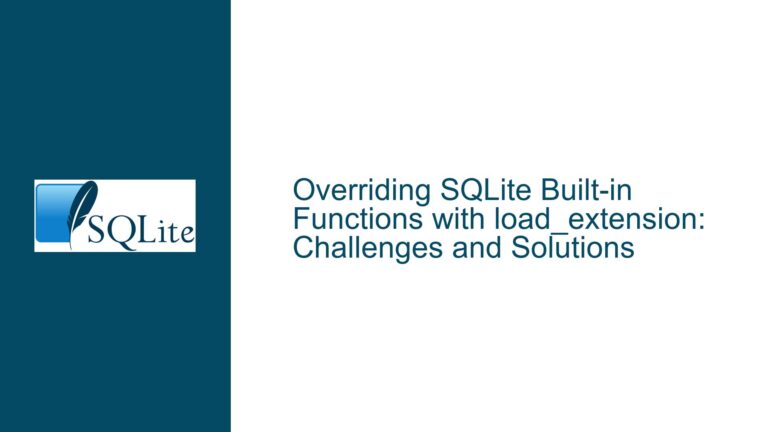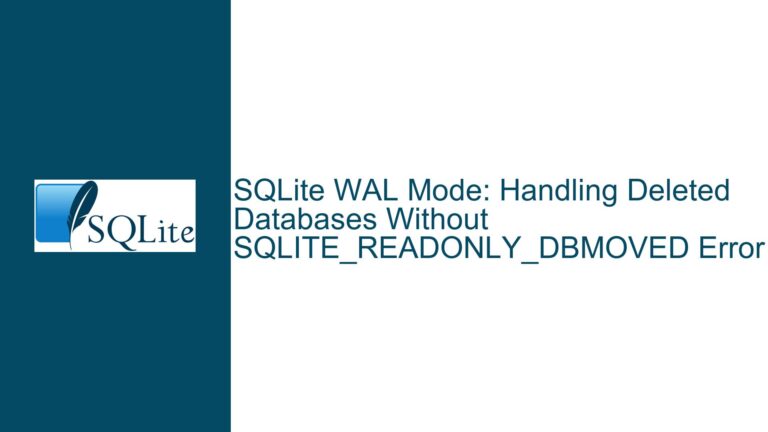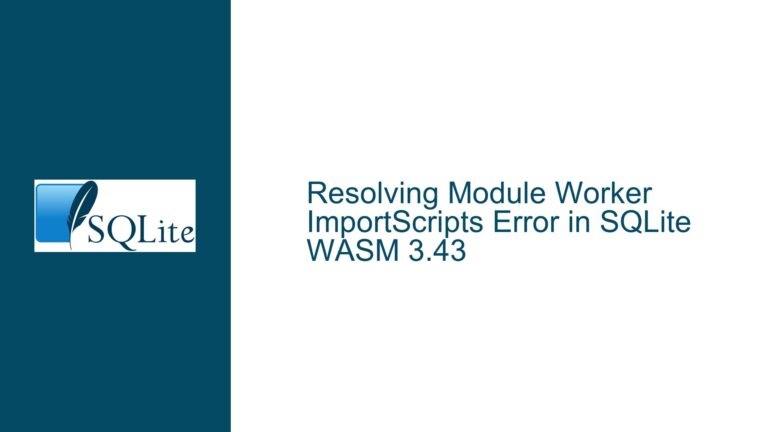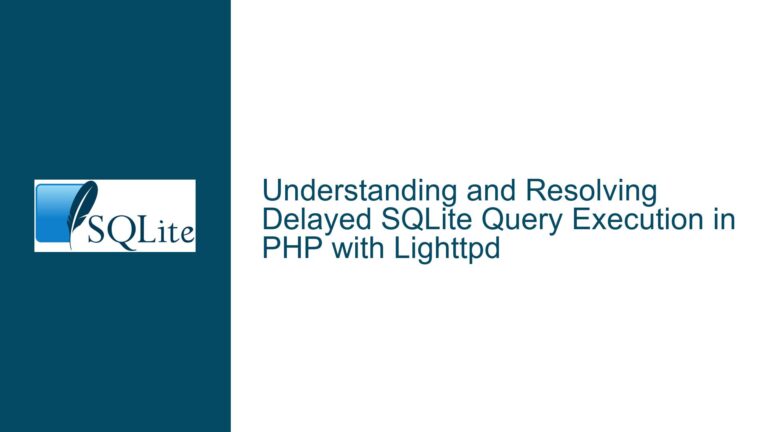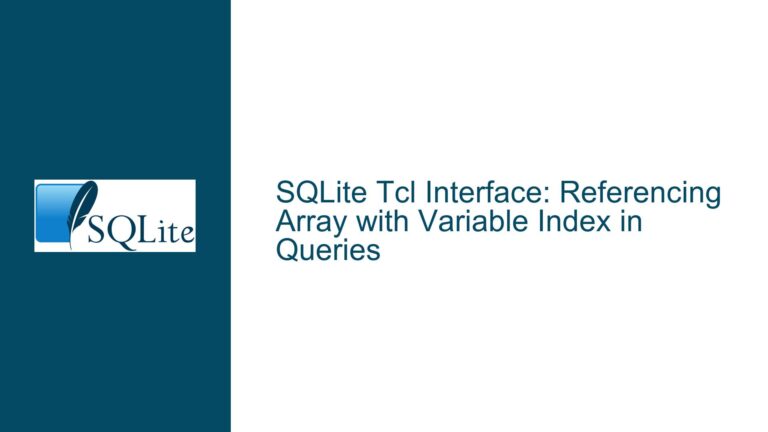SQLite Dump Missing application_id and user_version: Causes and Solutions
Understanding the Absence of application_id and user_version in SQLite CLI Dumps
The SQLite command-line interface (CLI) is a widely used tool for interacting with SQLite databases. Among its features, the .dump command generates a text-based representation of the database schema and data, which is invaluable for backups, migrations, or debugging. However, users often encounter a critical omission in the output of .dump: the application_id and user_version pragma values are not included. These values are essential for applications that rely on them to manage database versioning, compatibility checks, or application-specific metadata. When absent from dumps, reconstructing databases to their exact original state becomes challenging, requiring manual intervention or workarounds. This guide explores the root causes of this omission, its implications, and practical solutions to ensure these values are preserved during database dumps.
Core Mechanisms of application_id and user_version in SQLite
The application_id and user_version are 32-bit unsigned integers stored in the database file header. They serve distinct purposes:
application_id:
Defined by thePRAGMA application_idcommand, this identifier allows applications to mark a database file as belonging to them. For example, an application might setapplication_idto a unique value to prevent accidental misuse of its databases by other software. It is stored at bytes 68–71 of the database header.user_version:
Controlled viaPRAGMA user_version, this value is intended for developers to track schema versions. Applications often incrementuser_versionwhen deploying schema changes, enabling runtime checks to determine if migrations are needed. It resides at bytes 60–63 of the database header.
Both values are critical for maintaining database integrity across application updates. However, the SQLite CLI’s .dump command does not include these pragmas in its output. This omission means that restoring a database from a dump will result in application_id and user_version being reset to their default values (typically 0) unless explicitly set afterward. The absence of these values in dumps disrupts workflows that depend on them for version control or application-specific validation.
Why application_id and user_version Are Excluded from CLI Dumps
The exclusion of application_id and user_version from SQLite CLI dumps stems from design decisions and historical limitations:
Pragma Scope and Dump Functionality:
The.dumpcommand is designed to output SQL statements that recreate the database schema and data. Pragmas likeapplication_idanduser_versionare not part of the schema itself but are metadata stored in the database header. The CLI’s.dumpfocuses on schema objects (tables, indices, triggers) and data, omitting header-level pragmas.Backward Compatibility Concerns:
SQLite prioritizes backward compatibility, and changes to the.dumpoutput could affect existing tools that parse its output. Including new pragmas might break scripts expecting the traditional dump format.Assumption of Post-Dump Configuration:
The SQLite team assumes that users can manually setapplication_idanduser_versionafter restoring a database. The.dbinfocommand in the CLI provides these values, allowing users to retrieve them before generating a dump. However, this requires additional steps that are not integrated into the dump process.Default Value Optimization:
By default,application_idanduser_versionare 0. The CLI may omit these pragmas to avoid cluttering the dump output with unnecessary statements when values are unmodified. However, this optimization becomes a hindrance when non-zero values are in use.Lack of Built-in Hex-to-Integer Conversion:
As noted in the forum discussion, extractingapplication_idanduser_versionfrom the database header requires interpreting hexadecimal values stored in thesqlite_dbpagevirtual table. SQLite lacks a native function to convert these hex strings to integers, complicating efforts to automate their inclusion in dumps.
Preserving application_id and user_version in SQLite Dumps: Strategies and Workarounds
To address the absence of application_id and user_version in SQLite dumps, developers can employ a combination of manual interventions, CLI enhancements, and scripting. Below are detailed solutions:
1. Manual Extraction and Pragma Injection
Step 1: Retrieve Current Values
Use the .dbinfo command in the SQLite CLI to obtain application_id and user_version:
sqlite> .dbinfo
database page size: 4096
write format: 1
...
application id: 1337
user version: 9090
Step 2: Modify the Dump File
After generating the dump with .dump, manually append the pragmas to the output file:
PRAGMA application_id = 1337;
PRAGMA user_version = 9090;
Step 3: Restore the Database
When restoring, execute the modified dump file. The pragmas will set the header values correctly.
2. Leveraging the sqlite_dbpage Virtual Table
Enable the SQLITE_ENABLE_DBPAGE_VTAB compile-time option to access the database header via the sqlite_dbpage virtual table.
Step 1: Extract Header Values
Query the header to retrieve user_version and application_id as hex strings:
SELECT
hex(substr(data, 61, 4)) AS user_version_hex,
hex(substr(data, 69, 4)) AS application_id_hex
FROM sqlite_dbpage()
WHERE pgno = 1;
Step 2: Convert Hex to Integer
Use a scripting language (e.g., Python) or manual calculation to convert the hex values:
user_version = int("00002382", 16) # Output: 9090
application_id = int("00000539", 16) # Output: 1337
Step 3: Inject Pragmas into Dump
Add the converted values to the dump file as shown in Solution 1.
3. Automated Scripting for Dump Generation
Create a script that combines .dbinfo, .dump, and pragma injection.
Example Bash Script:
#!/bin/bash
DB_FILE="mydb.sqlite"
DUMP_FILE="mydb.dump.sql"
# Retrieve application_id and user_version
APP_ID=$(sqlite3 "$DB_FILE" "PRAGMA application_id;")
USER_VER=$(sqlite3 "$DB_FILE" "PRAGMA user_version;")
# Generate dump
sqlite3 "$DB_FILE" ".dump" > "$DUMP_FILE"
# Append pragmas
echo "PRAGMA application_id = $APP_ID;" >> "$DUMP_FILE"
echo "PRAGMA user_version = $USER_VER;" >> "$DUMP_FILE"
This script ensures the pragmas are automatically added to the dump file.
4. Feature Request for SQLite CLI Enhancement
Advocate for a CLI enhancement to include application_id and user_version in .dump output when non-zero. Developers can submit a patch to the SQLite team or vote for existing proposals. A proposed modification to the src/shell.c.in file in the SQLite source code could conditionally include these pragmas:
if( dbdata.application_id != 0 ){
raw_printf(p->out, "PRAGMA application_id=%d;\n", dbdata.application_id);
}
if( dbdata.user_version != 0 ){
raw_printf(p->out, "PRAGMA user_version=%d;\n", dbdata.user_version);
}
5. Alternative Backup Strategies
Use SQLite’s backup API or the VACUUM INTO command to create binary copies of the database, which preserve all header values:
VACUUM INTO 'backup.sqlite';
Binary backups retain application_id and user_version without requiring manual intervention.
By understanding the reasons behind the omission of application_id and user_version in SQLite dumps and applying the strategies above, developers can ensure these critical values are preserved. Combining manual extraction, scripting, and advocacy for CLI enhancements provides a comprehensive approach to maintaining database integrity across backups and restores.

